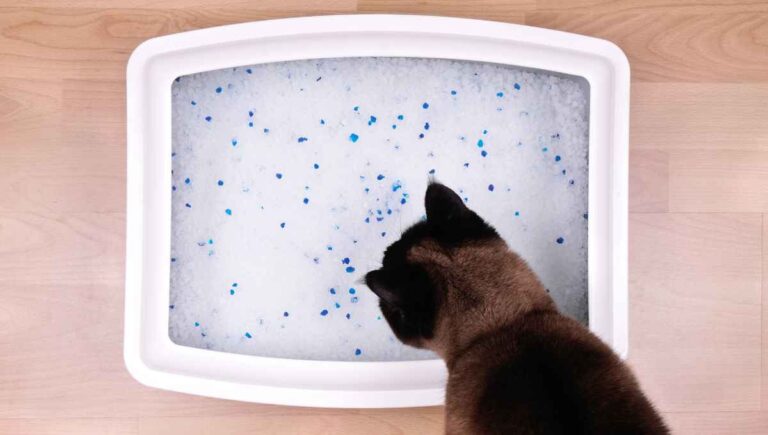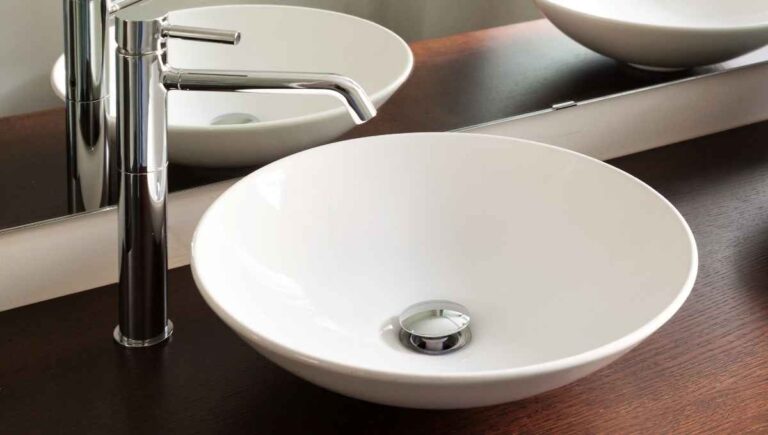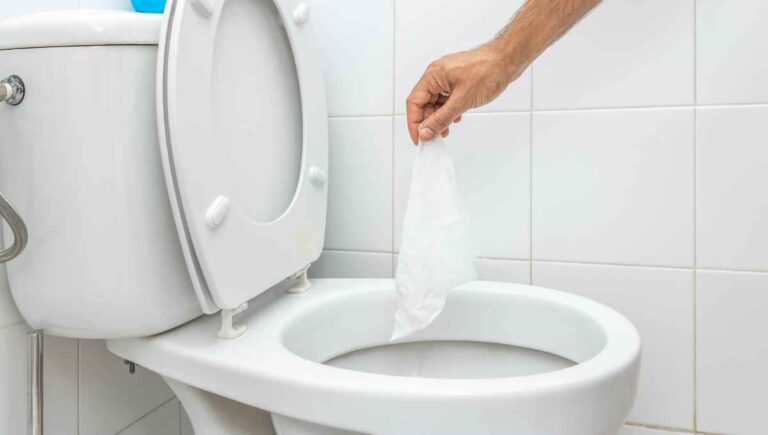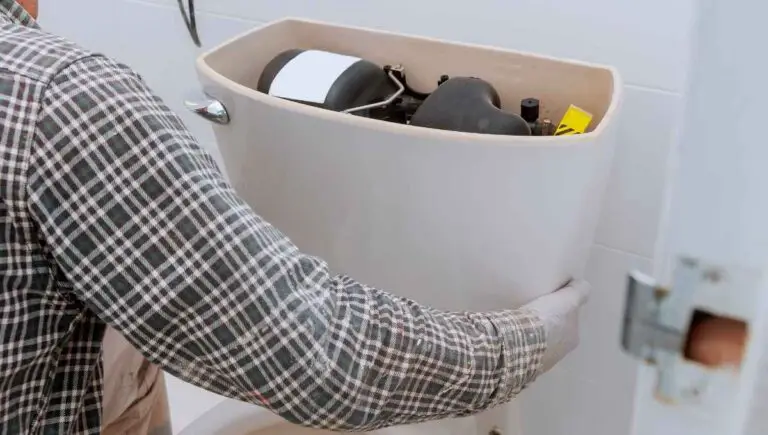Can a Bathtub Drain Freeze? (Do This to Prevent Freezing)

If you noticed your tub drain is not working properly without any visible reason, you’re probably asking yourself whether or not a bathtub drain can freeze. A frozen drain is a matter that should be taken with extreme care and concern, and hopefully, the right information can help ease your worries. So, is this possible?
A bathtub drain can freeze when it either holds standing water or its pipes are not properly insulated. Drain pipes can also freeze if they are exposed to the cold weather from the outside. You can manually thaw these by carefully applying heat to the frozen area to prevent bursting the pipe.
The mere possibility of this happening can destroy anyone’s hot-bathing dreams. Therefore, in this article, we will discuss whether or not a bathtub drain can freeze, what to do if you have frozen pipes, what to look out for when preparing for winter, and what are the best remedies to quickly thaw a frozen drain pipe.
This post contains affiliate links. This means Household Blogger may earn a commission should you make a purchase using any of our links. Please refer to our full affiliate disclosure policy for full details.
Here’s a Quick Pro Tip!
Unfortunately, a bathtub drain can freeze. However, what freezes is the drainpipe itself and not the drain specifically.
Yet, there are many methods that you can use to get rid of the ice swiftly without damaging your pipes.
These products can help you with your frozen pipes:
1. Cordless Heating Gun – To defrost your pipes quicker.
2. Revlon Hair Dryer – You can unfreeze your pipes and give yourself a blowout at the same time!
3. 2-Pack Heating Lamp – For more potency.
Is It Possible for a Drain Pipe to Freeze?
Since we already have a vague understanding that a drain pipe can freeze, let’s learn about how likely this is so hopefully, you can prevent it from happening in the future.
Is It Possible for a Bathtub Drain to Freeze?
Your bathtub drain can freeze during the colder months of winter. However, what freezes is the pipe that connects to the drain and not the drain itself. Many factors can lead this to happen – one of the major factors being a lack of preparation for winter.
Unfortunately, it is very possible that your bathtub drain can freeze.
It’s important that before the beginning of winter, you make sure to gather all the information on how to best protect your pipes to learn how to avoid having them freeze.
Can a Drain Pipe Freeze?
There is always a risk of having a frozen drain pipe during harsh winters. Ignoring it can provoke severe damage to your floors and walls. It’s best to make sure to take preventative measures to avoid it, which can save you money in the long run.
This doesn’t only happen with drain pipes, but it can also happen with sewer pipes. Usually, the culprit is either standing waters or any blocked wastewater drains. Lack of insulation or a running faucet can also provoke blockage, and it’s very inconvenient.
How to Check if Your Bathtub Drain Is Frozen?
You can find out if your bathtub drain is frozen when you see that your faucet stops running water, or if the bathtub drain is starting to act as if it was clogged. Make sure to check thoroughly before confirming.
You shouldn’t assume at first instance that a clogging bathtub is provoked by a frozen pipe. Dirt and other gross stuff that’s within the drainpipe or topper can also be the culprit behind this misbehavior.
So, if you want to check whether or not your tub drain is frozen, you should look out for the pipes that are either exposed on exterior walls or simply outside.
Touching them and feeling whether they’re warm or cold can give you the proper hint.
How Do I Know if My Drain Is Frozen or Clogged?
The most common signs that can tell you whether or not your drain is frozen or clogged are when you notice that there is little water pressure coming from the faucet or showerhead, or simply if there’s no water activity at all.
In other words, you will find out when you decide to use any faucet that’s within your home.
For example, if you notice that you have one faucet that’s working well, but the remaining faucets aren’t, surely there is a blockage somewhere within your pipes.
However, clogging is less difficult to notice. You can usually check inside the drain and see if there’s anything that’s obstructing the way. The most common things to find inside are hairs, debris, and other stuff, not to mention that oily substances can block them as well.
You are safe to assume that you have a frozen drain pipe when you are under 32 degrees Fahrenheit and you notice your bathtub drain clogging.
Make sure to search for the right ways to treat it before it’s too late.
You might also enjoy our post on If Bathtubs Have a Weight Limit
Is It Bad That My Bathtub Drain Froze?
Frozen drain pipes and sewer pipes often constitute an emergency because of the hazard they can provoke to your home. The water that’s frozen inside the drainpipe will expand, creating strong pressure that can provoke it to burst and result in severe flooding.
So, it’s not only bad, it’s dangerous. A burst pipe is guaranteed to provoke flooding that’ll most likely damage your floors.
Also, let’s not forget that our bodies can react to drastic temperatures in diverse ways.
And, it will be tremendously expensive to fix everything, especially when you need to do it fast. It’s best to treat it now that you found out, rather than just wait.
If you’re unsure of what to do, you should consult a professional.
Causes of a Freezing Drain
Now that you know that it’s possible that pipes freeze, let’s dig into what makes a drain freeze so we can avoid this disaster altogether!
What Causes a Bathtub Drain to Freeze?
A bathtub drain pipe can freeze if the pipe is exposed to cold temperatures, it hasn’t been insulated well, or if there was standing water within it that eventually froze as the temperatures got colder. Yet, our bathing products can also be the culprit.
Believe it or not, our shampoos, conditioners, and other liquid soaps that may contain essential oils, or the like, may have caused our drains to freeze.
But, if you had a leaking bathroom, kitchen, or laundry appliance, they could also be the culprit.
The thing to be very careful about is the insulation that your pipes currently have. Preparing for winter before it strikes can be very beneficial, so that’s why it’s often recommended.
Why Is My Bathtub Drain Frozen but Not the Sink Drain?
Both the bathtub and the sink have a P-trap with standing water in them to prevent the sewer gases from going back to your house. Often, these freeze during winter. However, the sink is usually more prone to freeze faster than a bathtub.
So, having a bathtub drain frozen means that this pipe is the one that is exposed to the cold temperature, unlike the sink drain pipe. However, if left untreated, the other one can freeze too.
That is one thing to consider, however, make sure that your bathtub isn’t clogged. Thinking of it as a clog seems more logical if we consider that sink drains are more exposed to freezing than bathtubs.
Check everything thoroughly before confirming it’s frozen.
Can Frozen Pipes Cause a Drain Clog?
If your pipes freeze, it can provoke your faucets to act as if they were clogging. Therefore, for many homeowners, this can be very confusing at first and oftentimes they find out they have frozen pipes after the water stops running completely.
Frozen pipes imply that there is frozen water inside, hence provoking a blockage. So, you can safely say that this blockage is a form of drain clog, but much worse.
How to Thaw Frozen Drain
So, unfortunately, you weren’t able to prevent a frozen drain. But, that’s okay! Thankfully, there are ways to thaw the frozen drain so you can get back to your warm baths.
Can Frozen Pipes Thaw on Their Own?
Ice can melt once the weather around it turns into a warmer state. So too, pipes can thaw on their own and function the way that they’re intended to. Yet, it’s not recommended to let them do it on their own because you still have a risk of having a burst pipe.
Knowing the nature of winter, temperatures can drastically change. While today you may have a 20 degrees Fahrenheit, tomorrow it can easily drop to -6 degrees.
You can safely assume that letting them thaw on their own will take much more time than preferred, and this is not very good if you want to avoid bursting pipes and flooding.
At What Temperatures Will Frozen Pipes Thaw?
The weather has to reach, at least, 32 degrees Fahrenheit so that the pipes can begin thawing on their own. Anything below that estimate surely will continue to keep them frozen. It’s best to look for quick solutions rather than just waiting.
The things mentioned above are the reason why it’s not okay to let them thaw on their own, but rather it’s best to ask for professional help in case you notice any starting damages on your pipes.
Frozen pipes aren’t something to play with. If one of them bursts, you will have to make huge expenses to fix, replace or change your current pipeline materials. These repairings can take time.
How Do You Unclog a Bathtub Drain?
There are multiple methods that you can use to unclog a bathtub drain. They’re not difficult to make, and the ingredients are often found in your kitchen or even in your closest supermarket. Make sure to do it strictly according to the instructions.
Here are a few things to do before attempting to make home-made remedies for clogging drains:
- Check for hairs in your drain topper, or within the drain. You can use rubber gloves to clean them.
- If removing the hairs within the topper or drain didn’t work, then purchase a drain claw. It will help you clean further into the drain.
If none of these work, then you can proceed to use the remedies many of us love, like baking soda and vinegar. Just the mixture to boiling water, then use a cup to apply it to the drain.
Fill it, apply, wait a few minutes, and repeat. Don’t do it all at once, or you might damage your pipes.
You can also use a plunger. Fill the bathtub with relatively warm water (not 100% hot). Make sure it’s a few inches deep. Then, use the plunger against the drain. Push, and pull vigorously until all the debris gets out.
If the abovementioned remedies didn’t work, then you might need to use bleach to unclog your drain. We recommend that this bleach comes in the form of gel, for better performance.
In any case, you can try to find a chemical drain cleaner that will help you unclog your drains. Yet, this option should be the last one to consider, as it’s better to use non-toxic products in your home.
How Do You Thaw a Frozen Drain Pipe?
The first step to thawing a frozen pipe is to locate the frozen pipe. They are located inside or outside the walls of your house. Others can be located beneath the floor, underneath the sink that’s outside a wall, or in an attic, crawlspace, or cellar.
Once you begin searching for the frozen pipe, determine whether it’s only a water pipe or the mainline. You will be able to figure this one out by opening the faucets in your home.
If none of the faucets work, then it’s the main line, but if only one is malfunctioning, then it’s just a pipe.
Get to feel the pipes with your hands. A pipe that still has water running will feel slightly warm to the touch, unlike a frozen pipe.
Once you find it, then all you need is the tool to thaw it.
Here are four ways to thaw your pipe:
- Hairdryer – After opening a faucet, use a hairdryer in the area. It can help you thaw the pipe.
- Portable heater – Using an electric portable one, direct it to the frozen section of your pipe. Make sure to open the faucet first.
- Electric heat tape – You can use this by wrapping it around the pipe. WARNING: Don’t use it on broken or leaking pipes, as you risk electrocution.
- Heat lamp – This can also help you. After opening a faucet to keep water running, direct it onto the frozen section to help melt the ice within.
Caution: make sure to be careful if you have a PVC pipe since heating it too quickly can actually melt the pipe and may result in breaking it.
How Do You Unfreeze Pipes Quickly?
A quicker way to unfreeze pipes is to apply boiling water to the drain. Yet, you must mix it with salt first, as salt helps lower the melting point of ice. Even so, you should be careful when doing it because you could risk bursting your pipes.
Meaning, that if you want to do it, use a cup to pour it down the drain. Don’t throw all the water at once because you may provoke the pipe to burst and result in worse situations.
Pour water down the drain with a cup, wait for a few minutes, then repeat.
After following the abovementioned steps thoroughly, make sure to check if the water is finally running. Open a faucet with cool to warm water before beginning so that the process is safer.
You might also enjoy our post on How Much it Costs to Fix a Cracked Bathtub
Can a Plumber Thaw Frozen Pipes?
A plumber will surely know how to properly thaw a frozen pipe without bursting it. Usually, they use a heat gun to apply warmth to the pipe, in a careful fashion. They must make sure to do it that way to avoid causing drastic temperature changes to the pipe.
As they apply the heat gun, they must make sure that it’s not done so in an abrupt manner. If they don’t make sure to follow safety protocols, they could end up provoking more damage than providing a solution.
A good plumber knows all of the abovementioned things. So, if you don’t have an idea about what to do regarding your frozen pipes, don’t hesitate to call them.
Will Salt Water Unfreeze Pipes?
Using saltwater to unfreeze pipes is an effective method to quickly thaw your pipes. The reason is that they lower the melting point of ice. However, the way to use it shouldn’t be taken lightly because the wrong move can break your pipe.
If you decide to use this method, make sure to follow safety measures to avoid damaging your pipes.
Try to turn on the water from your bathtub or sink and swift it from cold, to warm, gradually, before applying this remedy.
Then, at the same pace, pour boiling water with salt down the drain gradually.
Don’t attempt to pour in all the hot water in one shot, unless you want to break your pipes and waste money repairing them.
Will Anti-freeze Melt Ice in Pipes?
Antifreeze is a tool utilized for preventing your pipes from freezing. It won’t melt your frozen pipes, since the tool is mostly a prevention method and not exactly a thawing tool. You can use it for your bathtub, your pool, your sink, and even your RV plumbing.
And even though an Anti-freeze promises to keep your pipes from freezing, some may work better than others. So, keep this in mind when considering getting one at your local store, or online.
Can You Pour Hot Water on Frozen Pipes?
Pouring hot water on frozen pipes can either be the best thing you could ever do to your pipe or the worst thing. The matter doesn’t depend on pouring hot water in itself, but mostly on how the water was poured while attempting to thaw it.
For example, if you choose to throw hot water drastically down your tub, you risk bursting the frozen drain pipe.
But, if you take safety measures seriously and make sure to do it moderately rather than instantly, then it might help you get somewhere.
How Do You Unfreeze Plastic Water Pipes?
To melt the ice inside the plastic pipe, you need a towel and a hairdryer. In this case, you should open faucets and valves connected to the frozen pipe, and later apply the hairdryer heat to the frozen spot, while moving it back and forth to avoid damaging it.
When it comes to plastic water pipes, extra safety measures must be taken. They are very sensitive to both warm and cold temperatures, and therefore may burst quicker than other pipe materials.
Pouring boiling water in them is highly discouraged.
Will Drano Freeze if I Pour It Down My Drain Pipes?
Drano is a product that was created specifically for clogged drains and other stuff related to plumbing. They’re not made to make your pipes thaw on their own quicker, nor will assist them in the process. And, they’re not recommended to use on your pipes.
The reason that they’re not recommended for use is that the substance that the product uses often hardens within the drainpipe.
While it temporarily works to get rid of and prevent disturbing clogging, over time the product itself will harm the pipe.
Of course, Drano promises that their products are safe to use on their pipes, although consumers have reported otherwise.
Whether this is true or not, it will be confirmed if you take the leap and experience it yourself.
How to Prevent Frozen Drains
Now that you know how to thaw frozen pipes, you need to learn how to prevent frozen pipes so you never have to thaw them again!
How Do You Prevent a Bathtub Drain From Freezing?
To prevent a bathtub drain from freezing, you must make sure to have all the proper tools and information to prepare yourself for the upcoming winter. You must make sure to plan to insulate your pipes, especially if you’ll be out of town.
If you have your heater on, then the task is much easier. You can leave the cabinets of your kitchen sink or bathroom sink open to making sure that the warmth of the home keeps the pipes warm too.
Some people recommend leaving a faucet with warm water on during winter, but others strongly advise against it. This preventive method can backfire if it’s not done well.
If you’re going to be out of town, make sure that all the drains of your house are empty before turning off the water supply of your house.
Again, insulate your pipes with the right tools and you won’t have to worry further.
What Can I Put In My Drain to Keep It From Freezing?
If you want to take extra precautions after insulating your pipes, you can use an anti-freezing tool that helps with this task. You just have to pour the liquid down the drain, and it’ll do the rest of the job. What makes this possible is the P-trap.
As you throw the Anti-freeze liquid into your drain, the water that was standing in the P-trap will leave.
So, what will stand inside there is the anti-freeze, so hopefully, you won’t have any issues with frozen pipes after using it.
How Do You Wrap Pipes to Prevent Freezing?
To prevent your pipes from freezing, wrap your pipes with either a pipe sleeve or electric tape. The type of material you use will depend on what type of pipe you have, so your first step is to check what that is.
To insulate your pipes, you must know the products that best suit them. To know this, you must first understand the material that your pipe is made with before purchasing one of these tools.
If you don’t you may harm your pipe.
You get the option of choosing between a pipe sleeve and an electric tape. A plastic pipe should only be wrapped with an automatic heat tape, otherwise, it can suffer harm.
You have to calculate the length and diameter of your pipes to see how much you’ll need to buy. You’ll also need to count the faucets or valves.
The best way to use them is to follow the instructions that come with the product.
Related Questions
How Do You Thaw Frozen Drain Pipes in a Mobile Home?
Thawing frozen drain pipes in a mobile home is not so different from doing so in a regular home. What you need to do first is determine which area is frozen, and then use a hairdryer or heat gun that can help you melt the ice within the pipe.
After you find the frozen section of your pipe, apply heat carefully to that spot of your pipe. Make sure to not do it too directly. Move back and forth to prevent damaging the pipe.
You can also use boiling water to thaw it.
Should I Leave the Faucet Open if Pipes Are Frozen?
Leaving a faucet open has a few complications. On one side, it can help you thaw your pipelines if done with extra tools or remedies. On the other, it can also make your pipe’s situation worse. In any case, you should opt to fix the frozen pipes before opening them.
The reality is that even though some people strongly recommend leaving a faucet open, just slightly, there is still a high risk that it could make your situation worse.
It’s better to call a professional that can guide you better rather than following advice from the street.
Final Thoughts
Bathtub drains have a possibility of freezing due to a lack of proper insulation and preparation for the upcoming winter.
The best way to take care of this issue is to call a professional that can guide you better in what to do.
However, if you want to thaw your pipes by yourself, there are multiple yet effective methods that you can do in a safe manner that won’t harm your pipes.
To thaw your pipes, first, you must investigate where the frozen section is. After finding the frozen section, make sure to apply the heat there being cautious of your pipe’s materials.
Using an anti-freeze can help you prepare for winter, as they come for different types of purposes. They can be used in pools, tub drains, sinks, kitchen sinks, and even RV plumbing.
The best way to prevent a situation in which you risk having burst pipes is to make a plan before winter arrives.
Consider every aspect that may affect the way that your plumbing works, and make sure to save a solid budget in case of any accidents.











